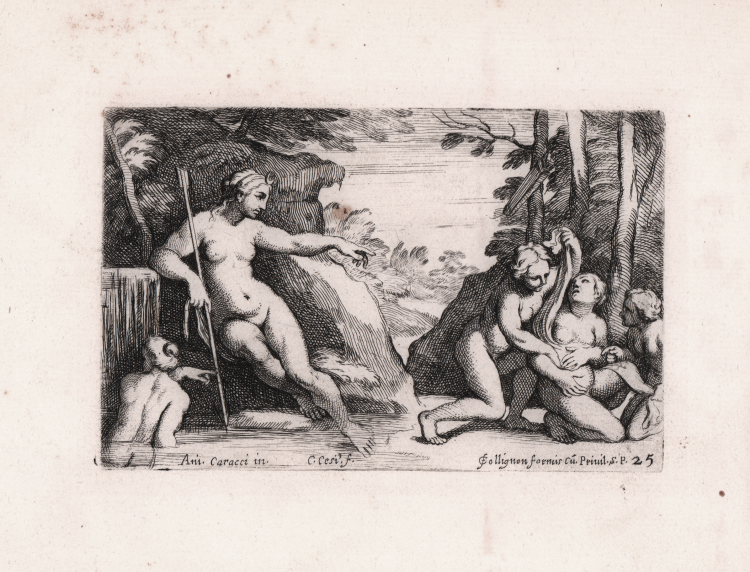


| Reference: | S35336 |
| Author | Carlo CESIO |
| Year: | 1657 |
| Measures: | 150 x 100 mm |


| Reference: | S35336 |
| Author | Carlo CESIO |
| Year: | 1657 |
| Measures: | 150 x 100 mm |
Carlo CESIO (Antrodoco 1626 - Rieti 1687)
|
Italian painter and engraver. After his education in Rieti, in the late 1640s Cesi went to Rome, where he became a pupil of Pietro da Cortona, who later introduced him to various patrons, including Queen Christina of Sweden and Cardinal Decio Azzolini, and supported his matriculation at the Accademia di S Luca in 1651. In 1657 Cesi took part in the decoration of the Galleria di Alessandro VII in the Palazzo Quirinale with his Judgement of Solomon (in situ). The fresco shows that he had not completely understood Baroque style but continued to build his compositions by adding figures, unable to reach a real unity. This weakness becomes more evident in his later works. In 1657, too, Cesi published his series of prints from Annibale Carracci’s frescoes in the Galleria Farnese. The series after Pietro da Cortona’s decoration in the Galleria Pamphili came out in 1661. The fame of these etchings, in which Cesi never reversed the image, was due to their faithfulness to the originals; they were highly appreciated in spite of the cold quality often imparted by this exactitude. Around 1660 Cesi painted the Marriage of St Catherine and the Holy Family for the Cesi chapels in S Maria Maggiore and S Maria della Pace, Rome, respectively. He worked in Rieti in 1673–4, and he retired in 1679. The period between 1672 and 1675 was his busiest at the Accademia di S Luca, where he was Principe in 1675. Cesi devoted much time and effort to teaching, as is testified by his book Cognizione dei muscoli (Rome, 1679).
|
Carlo CESIO (Antrodoco 1626 - Rieti 1687)
|
Italian painter and engraver. After his education in Rieti, in the late 1640s Cesi went to Rome, where he became a pupil of Pietro da Cortona, who later introduced him to various patrons, including Queen Christina of Sweden and Cardinal Decio Azzolini, and supported his matriculation at the Accademia di S Luca in 1651. In 1657 Cesi took part in the decoration of the Galleria di Alessandro VII in the Palazzo Quirinale with his Judgement of Solomon (in situ). The fresco shows that he had not completely understood Baroque style but continued to build his compositions by adding figures, unable to reach a real unity. This weakness becomes more evident in his later works. In 1657, too, Cesi published his series of prints from Annibale Carracci’s frescoes in the Galleria Farnese. The series after Pietro da Cortona’s decoration in the Galleria Pamphili came out in 1661. The fame of these etchings, in which Cesi never reversed the image, was due to their faithfulness to the originals; they were highly appreciated in spite of the cold quality often imparted by this exactitude. Around 1660 Cesi painted the Marriage of St Catherine and the Holy Family for the Cesi chapels in S Maria Maggiore and S Maria della Pace, Rome, respectively. He worked in Rieti in 1673–4, and he retired in 1679. The period between 1672 and 1675 was his busiest at the Accademia di S Luca, where he was Principe in 1675. Cesi devoted much time and effort to teaching, as is testified by his book Cognizione dei muscoli (Rome, 1679).
|